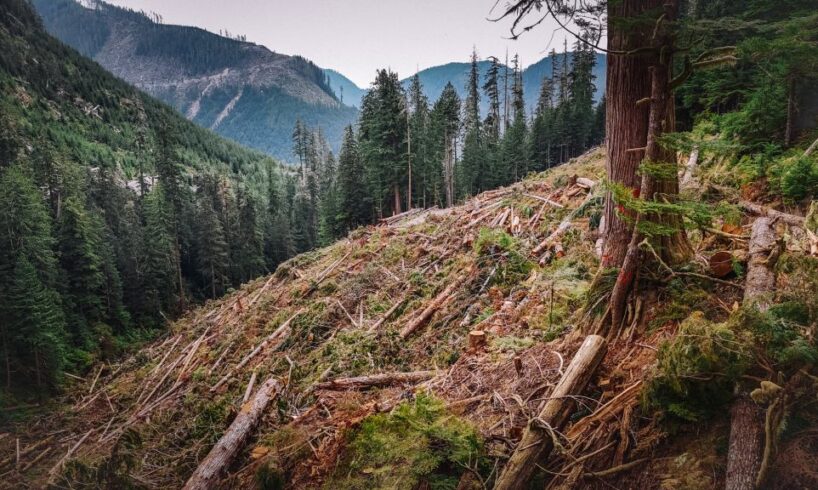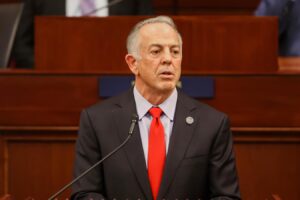
In early September 2025, as wildfires cast a pall of smoke across parts of B.C., Forests Minister Ravi Parmar was asked about a study from the University of British Columbia which found clear-cut logging can make catastrophic floods larger and much more likely.
“The clear-cut logging that I think people would assume is leading to that is 1950s-style harvesting,” Parmar said. “I don’t think that’s happening in British Columbia anymore. We lead with world-class silviculture practices.”
That statement might come as a surprise to some who have seen recent photos of logged areas of Vancouver Island’s Walbran Valley, which show once-dense forests cut down to nothing.
This cutblock in the Walbran Valley on Vancouver Island was logged in August 2025. Photo: Mike Graeme / The Narwhal
The minister’s comments came as a shock to Younes Alila, a professor at the University of British Columbia’s Department of Forest Resources Management and the lead author of the study Parmar was asked about.
“It sounds like he’s living on another planet, certainly not in British Columbia,” Alila, who has spent 30 years researching the way logging impacts watersheds, told The Narwhal.
The B.C. government’s forestry website defines clear-cutting as a type of logging that involves cutting entire stands of trees. This can happen all at once across an area earmarked for permitted logging — known as a cutblock in the industry — or piece by piece, a process known as strip cutting.
Sometimes, small stands of trees are spared — called clear-cutting with reserves — and B.C. also has rules to protect so-called special trees, the biggest and oldest specimens of certain species, including cedar, maple, fir and spruce.
Video: L. Manuel Baechlin / The Narwhal
When The Narwhal asked Parmar to clarify his claim that clear-cutting is an outdated forestry practice, the minister did not clarify. Instead, he said logging practices today involve more care than in the 1950s.
“I’m very comfortable with where we are in British Columbia in terms of the steps that are taken before a permit is submitted,” Parmar said.
B.C.’s current forestry practices balance environmental considerations and the needs of the provincial forestry industry, according to Parmar.
Alila disagrees.
“The clearcutting continues as we speak,” he told The Narwhal.
Younes Alila, a hydrologist in the University of British Columbia’s faculty of forestry, has been researching the effects of clear-cut logging on watersheds across the province. Photo: Daniel J. Pierce / The Narwhal
‘These are not hypothetical clear-cut logging scenarios’: forestry professor
Alila isn’t the only one raising eyebrows at Parmar’s statement. Tegan Hansen, senior forests campaigner with Stand.earth, called the minister’s claim “incredibly disappointing.”
“Clear-cutting happens in every part of B.C., from the Skeena to Vancouver Island to the Kootenays,” she told The Narwhal. “I think it’s an incredibly damaging statement.”
When a section of forest is clear-cut, it’s not just the trees that disappear, Hansen said. The understory also dies, including the ferns and shrubs and lichens and mosses that once grew from the forest floor up to the canopy.
“I’ve walked in clearcuts that were logged a few months ago in the summer, and the ground has started to bleach and all of that life is dead, and the logs have been removed, and the earth is churned up from the machinery,” she said.
Stripping trees from the land can have dire consequences. Alila’s research has shown that forest canopies help regulate the water cycle, slowing snow melt in the spring, which can help prevent sudden floods. Tree roots also help stabilize the soil and contribute to moisture retention, reducing the likelihood of drought.
“These are not hypothetical clear-cut logging scenarios,” Alila said of his study subjects. “These are actual cutblocks and actual, real watersheds in actual British Columbia.”
Old clear-cutting practices were ‘pure exploitation’: B.C. government
Mike Morris, a former BC Liberal MLA who represented the forestry-dependent Prince George-Mackenzie riding from 2013 to 2024, is an avid outdoorsman. He’s been hiking, hunting and trapping in northern B.C. forests since the 1960s — before clear-cutting became a widespread practice. Now, he’s regularly reminded of the scale at which local forests are being logged.
“It’s a shocking thing to see when you stand there and you can look around and for miles on either side of you, nothing but clearcuts,” he said, describing a 3,000-hectare clearcut that borders his trapline in northern B.C.
“It’s surrounded by a number of other clearcuts that equate to about 30,000 hectares in size over the last 25 years.”
Forty years ago, clear-cutting was by far the dominant type of logging taking place across B.C., according to data supplied by the Forests Ministry. In 2023, only 17 per cent of the area logged in B.C.’s southern Interior was clear-cut, according to the ministry, while eight per cent of coastal and northern cutblocks were clear-cut.
Forty years ago, clearcutting was by far the dominant type of logging taking place across B.C. Today, clearcutting with reserves is the most common logging practice. Photos: Desiree Wallace / Stand.earth
Clear-cutting with reserves is now the dominant practice, according to the ministry’s data. Ninety per cent of logged areas in the northern Interior were clear-cut with reserves; 74 per cent in the southern Interior and 47 per cent on the coast.
“Leaving a few trees here and there doesn’t change the practice,” Stand.earth’s Hansen said. “Ecologically, from the perspective of that forest, of all the life that relies on the forest, there’s no difference.”
Clear-cut logging remains “a viable and appropriate approach to sustainable forest management,” according to a statement from the Forests Ministry. While logging in the 1950s focused on getting as much timber out of B.C. forests as possible, a statement from the ministry said modern clear-cut logging accounts for ecological impacts at each specific cutblock.
The B.C. government’s online introduction to forestry practices says the way clear-cutting used to be done — a system known as “clearout” logging — “has given clear-cutting a bad name for some time.”
Unlike the “pure exploitation” of clearout logging, the modern clearcut system “manages a stand for the long term,” the document states.
In some parts of B.C., only small patches of forests remain between cutblocks. Photo: Mike Graeme / The Narwhal
Why is B.C. still clear-cut logging?
Morris believes that pressure from the forest industry coupled with B.C.’s increasingly uncomfortable financial situation has left the provincial government with little appetite to reform forestry, despite mounting evidence of the serious impacts of intensive logging.
“I find government maintains the status quo more often than not, just because it’s the easiest path to take,” he said. “But at what cost? At the cost of more lives, at the cost of more infrastructure damage that the taxpayers will have to bear?”
He’s particularly worried about the connection between losing tree canopies and natural disasters. “It’s causing landslides, it’s causing drought and it’s causing increased wildfire risk. To me, that is a clear and present danger that any minister should be aware of.”
Despite mounting evidence that clear-cutting increases the risk of costly disasters, clear-cutting remains a dominant logging practice in B.C. Photo: Mike Graeme / The Narwhal
Alila believes B.C.’s lack of action to curb clear-cutting comes down to dollars.
“Clear-cut logging is the cheapest way to cut the wood,” he said. “There are many other logging practices that are more eco-friendly. There are [a] wide variety of silvicultural practices that would have way less effects on hydrology and on wildlife, on biodiversity, but we keep resisting going there, unfortunately, because it’s the cheapest way.”
Even if B.C. were to abandon clear-cutting tomorrow, its effects could linger for a century before forests regain their capacity to moderate the water cycle and stabilize the soil.
“We’re going to be living with the effect of the clear-cut logging all over B.C. for decades to come,” Alila told The Narwhal.
Updated Nov. 20, 2025, at 11:49 a.m. PT: This article was updated to reflect the fact that Mike Morris served as an MLA from 2013 to 2024.





